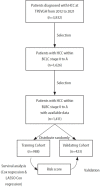Conventional and machine learning-based risk scores for patients with early-stage hepatocellular carcinoma
- PMID: 38600872
- PMCID: PMC11261226
- DOI: 10.3350/cmh.2024.0103
Conventional and machine learning-based risk scores for patients with early-stage hepatocellular carcinoma
Abstract
Background/aims: The performance of machine learning (ML) in predicting the outcomes of patients with hepatocellular carcinoma (HCC) remains uncertain. We aimed to develop risk scores using conventional methods and ML to categorize early-stage HCC patients into distinct prognostic groups.
Methods: The study retrospectively enrolled 1,411 consecutive treatment-naïve patients with the Barcelona Clinic Liver Cancer (BCLC) stage 0 to A HCC from 2012 to 2021. The patients were randomly divided into a training cohort (n=988) and validation cohort (n=423). Two risk scores (CATS-IF and CATS-INF) were developed to predict overall survival (OS) in the training cohort using the conventional methods (Cox proportional hazards model) and ML-based methods (LASSO Cox regression), respectively. They were then validated and compared in the validation cohort.
Results: In the training cohort, factors for the CATS-IF score were selected by the conventional method, including age, curative treatment, single large HCC, serum creatinine and alpha-fetoprotein levels, fibrosis-4 score, lymphocyte-tomonocyte ratio, and albumin-bilirubin grade. The CATS-INF score, determined by ML-based methods, included the above factors and two additional ones (aspartate aminotransferase and prognostic nutritional index). In the validation cohort, both CATS-IF score and CATS-INF score outperformed other modern prognostic scores in predicting OS, with the CATSINF score having the lowest Akaike information criterion value. A calibration plot exhibited good correlation between predicted and observed outcomes for both scores.
Conclusion: Both the conventional Cox-based CATS-IF score and ML-based CATS-INF score effectively stratified patients with early-stage HCC into distinct prognostic groups, with the CATS-INF score showing slightly superior performance.
Keywords: Fibrosis; Hepatocellular carcinoma; Inflammation; Machine learning; Prognosis.
Conflict of interest statement
There are no potential conflicts of financial and non-financial interests in the study. Chien-Wei Su: Speakers’ bureau: Gilead Sciences, Bristol-Myers Squibb, AbbVie, Bayer, and Roche. Advisory arrangements: Gilead Sciences. Grants: Bristol-Myers Squibb and Eiger.
Figures





Comment in
-
Unlocking the future: Machine learning sheds light on prognostication for early-stage hepatocellular carcinoma: Editorial on "Conventional and machine learning-based risk scores for patients with early-stage hepatocellular carcinoma".Clin Mol Hepatol. 2024 Oct;30(4):698-701. doi: 10.3350/cmh.2024.0327. Epub 2024 May 7. Clin Mol Hepatol. 2024. PMID: 38711303 Free PMC article. No abstract available.
References
-
- Bray F, Ferlay J, Soerjomataram I, Siegel RL, Torre LA, Jemal A. Global cancer statistics 2018: GLOBOCAN estimates of incidence and mortality worldwide for 36 cancers in 185 countries. CA Cancer J Clin. 2018;68:394–424. - PubMed
MeSH terms
Grants and funding
LinkOut - more resources
Full Text Sources
Medical
Miscellaneous

